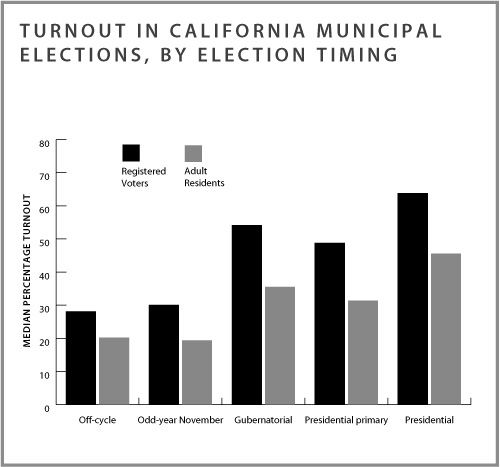As San Francisco moves toward a future system of “instant runoff” elections for the Board of Supervisors and other officials, it is worth pondering how the electorate itself might be shaped by containing elections to a single November date, rather than the historical practice of holding a runoff election in early December. As we know from the 2001 contest for city attorney, a “runoff-only” election during the holiday season—no matter how interesting the match-up—is not a recipe for widespread voter participation, as attested to by the 16.58 percent turnout of registered voters in last December’s election.
To put it plainly, timing is almost everything when it comes to turnout in municipal elections. Earlier this year, two colleagues and I released a study examining what factors influence voter turnout rates in city elections across California. The variations in voter participation are huge, with anywhere from 10 percent to 89 percent of registered voters casting ballots in recent mayoral and city council contests in the various municipalities. We found that numerous factors account for these differing levels of voter participation. For example, cities that provide more public services with their own staffs (as opposed to providing services with special service districts or by contracting with private firms) draw a slightly higher share of voters to the polls, as do cities with smaller populations, those with more candidates competing, and those with propositions on the ballot. Higher-income cities and those with larger shares of senior citizens in the population attract more voters as well.

All of these factors, however, pale in significance compared to the timing of the election. For example, cities that held their council elections on the same day as a presidential contest tended to draw about 36 percent more registered voters to cast ballots for council than cities that held a “local-only” election, as many cities in California (including Los Angeles) do in March or April. (See accompanying graph.) In general, cities that hold local elections concurrently with statewide and/or national elections draw far bigger shares of the electorate to the polls. Political science research indicates that the electorate in low-turnout elections is likely to be skewed toward wealthier and older voters (and people who have not moved recently), so a broader electorate should be good news for democratic inclusion.
Of course, the flip side of this coin is that people who do take the trouble to come to the polls for a “local-only” election tend to be highly motivated—sometimes incensed—about local politics. In cities that held elections concurrently with statewide contests, incumbent mayors and councilmembers were significantly more likely to be reelected than in “local-only” contests; this is probably because some voters in concurrent elections are not very tuned-in to local politics and rely on name recognition as a cue in casting their votes. In December 2000, when many in the current crop of progressives on the San Francisco Board of Supervisors easily won their runoffs against “establishment” candidates, some political observers were surprised, assuming that candidates backed by the incumbent mayor and substantial organizations would outmuscle challengers in a low-visibility, low-turnout environment. But our findings suggest that the “motivated voters” who show up for such off-cycle elections are more likely to be critics of local officials than loyalists.
If correct, this perspective suggests that the city’s elections this November—held during a gubernatorial race—may bring a body of voters to the polls who are, on the whole, somewhat less adventurous than those of December 2000. However, there will still be a December runoff, because the Elections Department has determined that it does not yet have the technology to implement the instant runoff, or “ranked choice” electoral system (passed by the voters as Proposition A in March 2002). In the December runoff, we can once again expect a low turnout, with “motivated” voters overrepresented.
In the long run, the bigger unknown for city elections remains how the instant runoff mechanism will or will not change the way voter preferences get aggregated into election outcomes. As always, San Francisco elections promise to be colorful and, most likely, to hold some surprises.